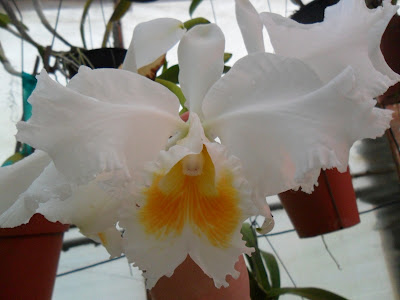After the spider experience I have been cautiously inspecting my Coelogyne tomentosa (previously C. massangeana) for flowers. The flower spike grew very rapidly. In fact I could see a difference in its length from the morning to the evening in the same day! The spike carried about 20 buds which opened recently. The flowers are pleasantly fragrant in the morning and in the evening but during the middle of the day they seem to lose their fragrance. I keep my plant next to my Phalaenopsis plants and it gets misted automatically 3 times during the day. Temperatures range from 18 Degrees C at night to 30 during the day with a high humidity and good air movement. Light is the same for my Phalaenopsis - semi-shade (about 60%).
At the same time that the C. tomentosa flowered I spied some maturing buds from a very old Cattleya hybrid that I purchased along with the greenhouse earlier this year. Unfortunately the tag is missing from this specimen but I am hoping to get it identified from the image of the flowers I recently took. The flowers are a deep velvet red. It is probably the most intense red I have ever seen before in an orchid. The camera which captured the image below did not do justice to the colour unfortunately but it does give an idea of its beauty.
 |
| unidentified red Cattleya hybrid |









